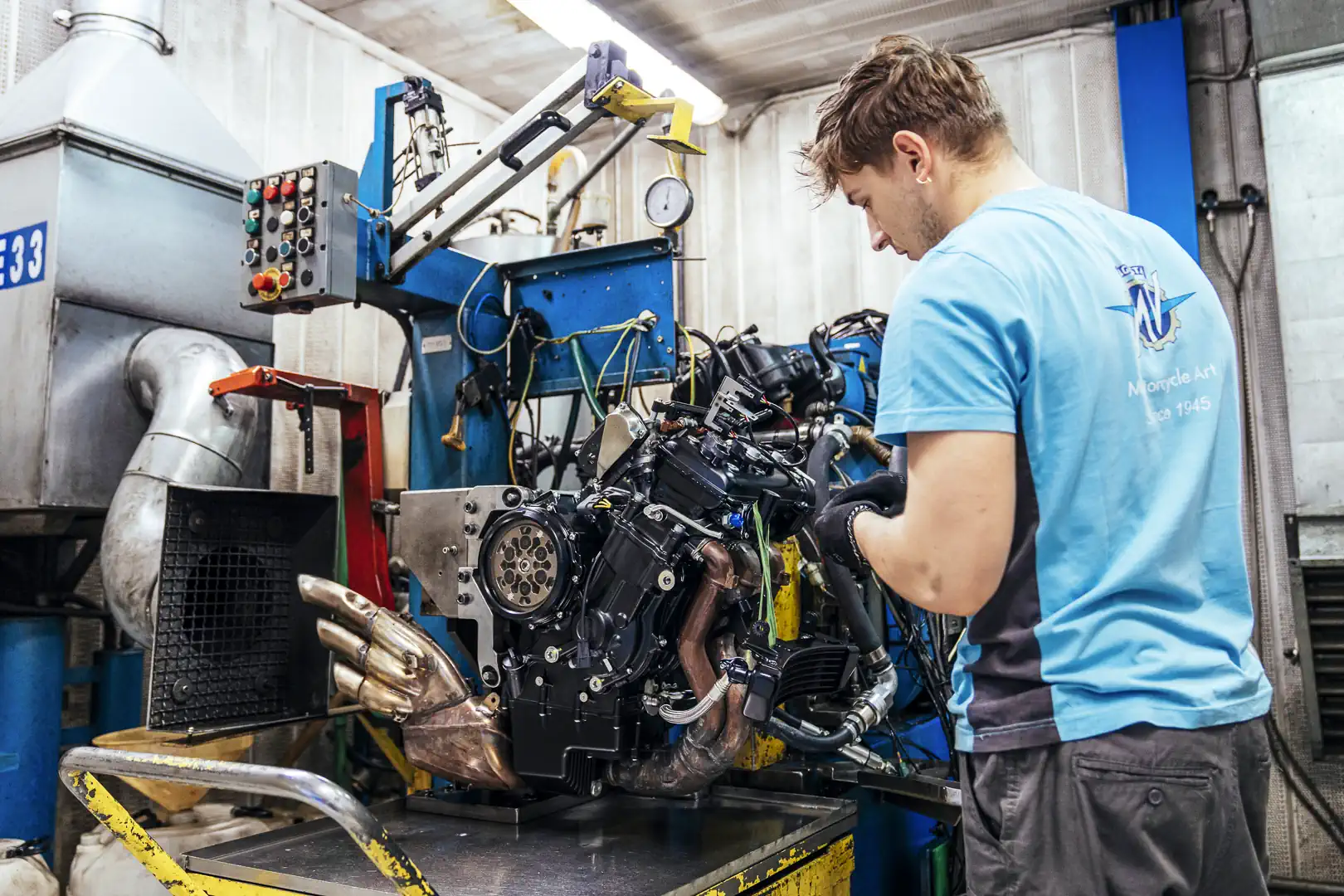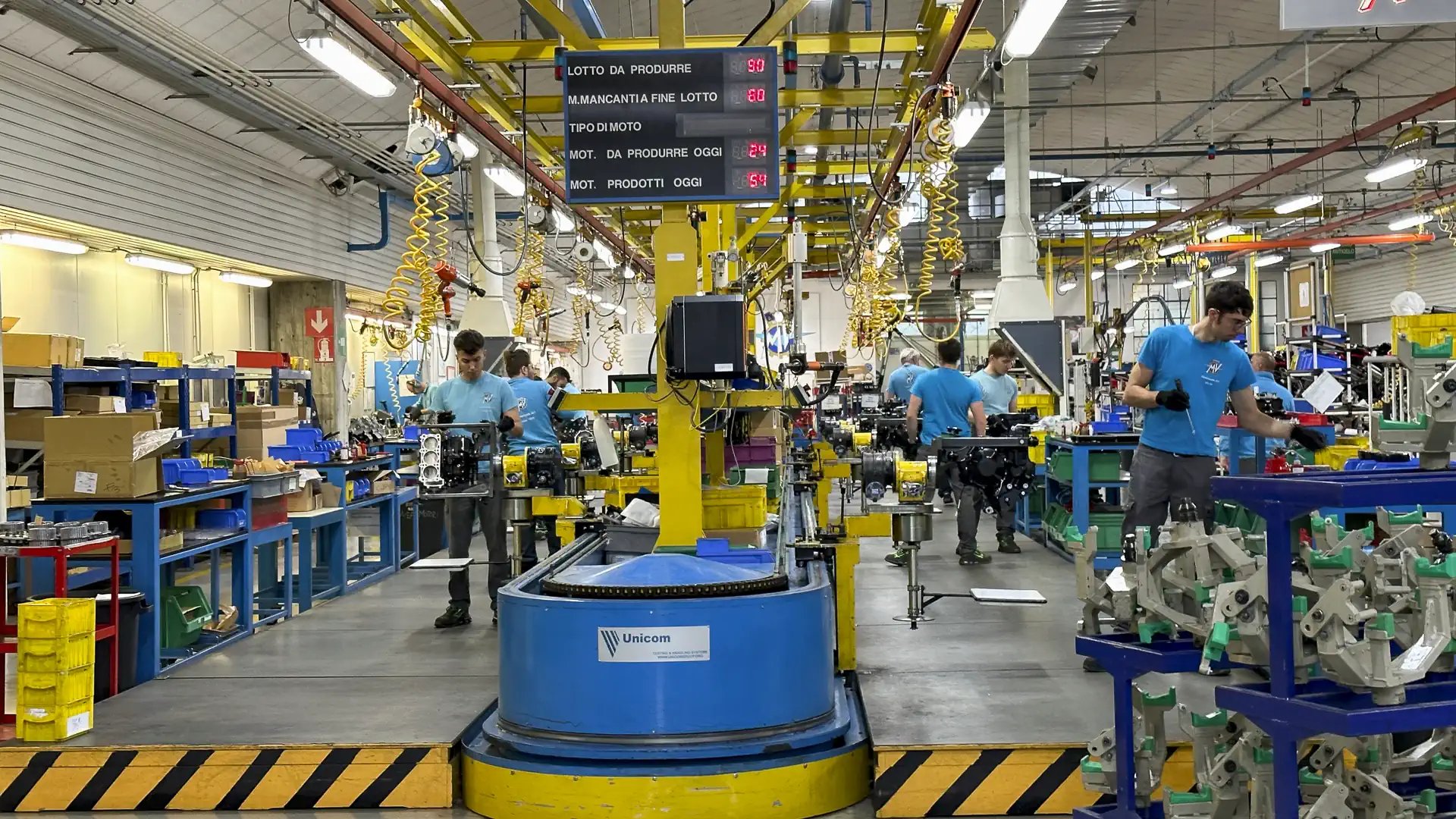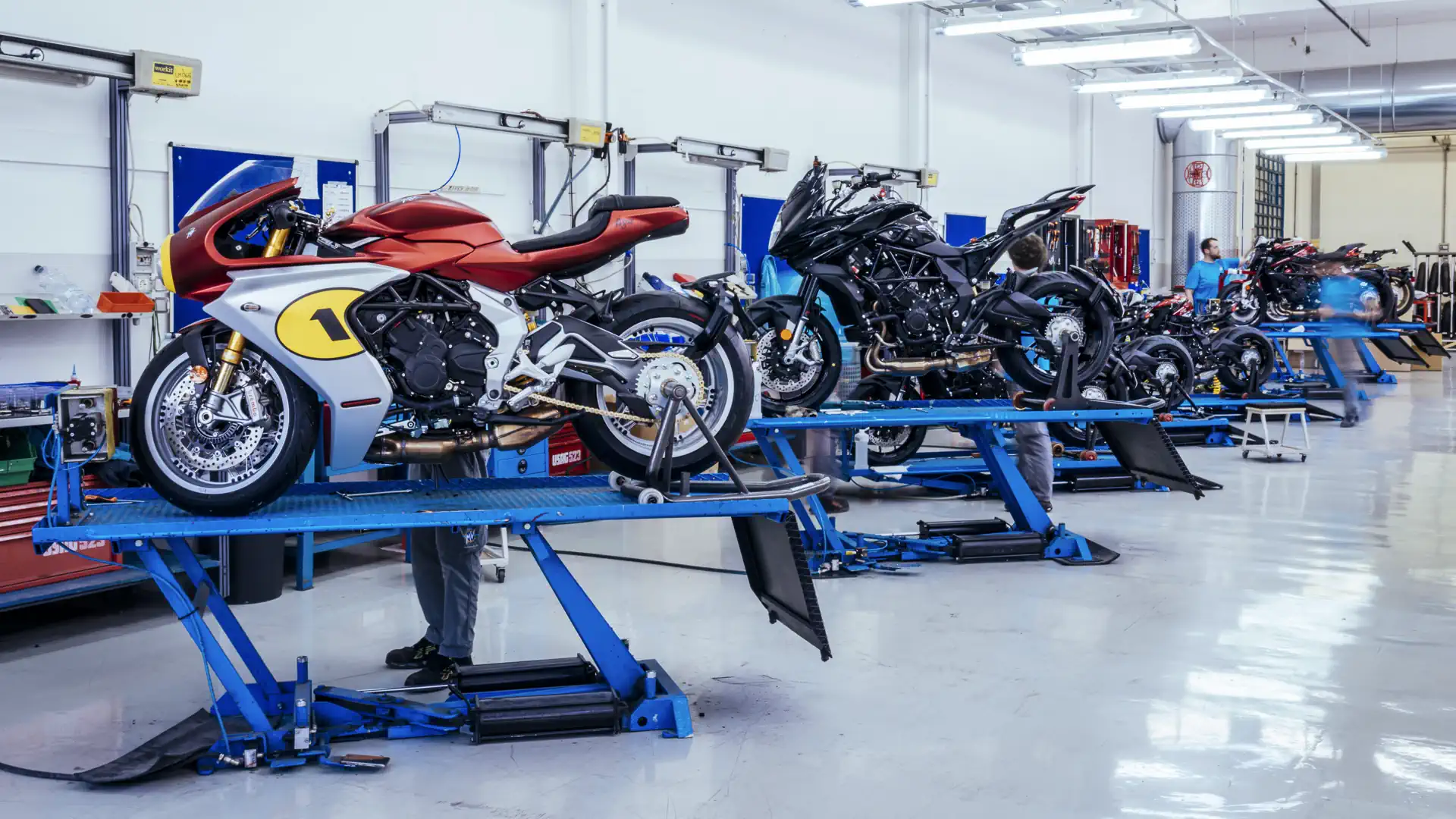Motorcycle Art is the tagline used by the fabled Italian marque MV Agusta, and it’s an apt description for the company’s exquisite-looking motorcycles. The snag is that the company hasn’t been nearly as good at making money as it is at making beautiful machines.
The company was founded in 1945 by Count Domenico Agusta as a division of the aviation company he had previously founded with his father. The initials MV stand for Meccanica Verghera, as that was the location of the company’s original factory, 25 miles northeast of Milan.

In its early years, MV Agusta produced mainly racing motorcycles. In its 78-year history, MV has won 38 rider world championships, 37 constructor titles, 270 Grand Prix races, and scored 3,028 podiums—most of which came in the 1950s and ’60s.
By the 1970s, MV Agusta had fallen on hard times, including the death of Count Agusta in 1971. MV’s final GP win was in 1976. Sales ended in 1980, and the MV Agusta brand went on hiatus for around ten years.
In 1991, the MV Agusta brand was sold to Cagiva, an Italian motorcycle manufacturer that already owned the Ducati, Husqvarna, and Moto Morini marques. However, by the early 2000s, financial woes forced Cagiva to surrender majority ownership to Proton—a Malaysian car manufacturer.

Further complex international finance machinations continued, including a 2008 purchase by Harley-Davidson with Claudio Castiglioni (the “Ca” in Cagiva) at the helm as President of MV.
As the Great Recession really started to bite, H-D’s involvement ended in 2010 when The Motor Company sold MV Agusta back to Castiglioni for just a single euro. After Claudio passed away from cancer at only 64 in 2011, his son Giovanni assumed control of MV.
By 2014, the recession started to recede, and Mercedes-AMG purchased a 25 percent stake in MV Agusta. Once again, hopes were high that this would be a great partnership. The two successful, high-performance, upper-echelon brands appeared perfectly aligned to sell premier-level products to the well-heeled luxury-hungry consumer. However, rumors quickly started that AMG wanted a larger stake in the company, but Giovanni was not prepared to give up control. By 2017, the wheels had fallen off that partnership as well.
Around the same time, Giovanni Castiglioni met Russian entrepreneur Timur Sardarov. Son of Rashid Sardarov, a multi-billionaire and owner of Cyprus-based Comsar Energy Group and Russia’s South Urals Industrial Company, Timur is a true motorcycle enthusiast. He owns many motorcycles, including several Harley-Davidsons, a Ducati Diavel, and perhaps significantly—an MV Agusta Dragster RR. Castiglioni and Sardarov immediately hit it off.

Remember those old Remington shaver TV ads: “l was so impressed I bought the company”? Well, it appears that Timur Sardarov felt the same way. In 2018, MV Agusta bought back AMG’s stake and sold it to Sardarov’s ComStar Invest investment fund, which became a minority shareholder in MV Agusta; Castiglioni’s GC Holding retained a controlling stake.
Sardarov moved his family to Italy in 2019, committing himself to ensuring that MV Agusta would flourish. Sadly, we’re all very familiar with what happened next—COVID-19. Sardarov’s timing couldn’t have been worse—or better—depending on your point of view. Castiglioni quickly left the picture, and Sardarov—after a rumored investment totaling around €100 million—became the sole owner of the fabled brand and manufacturer. It could be argued that Sardarov now owns the world’s most expensive Dragster RR.
Quickly, Sardarov found himself battling supply chain issues, the Putin invasion of Ukraine (which Sardarov opposes), and surging inflation. The challenges forced a brief production shutdown in March 2020. Fortunately, Sardarov is clearly made of stern stuff, and thanks to what must have been sheer strength of will, MV Agusta endured.

I chatted with Sardarov recently at an MV Agusta corporate event held at the storied Schiranna factory on the shores of Lake Varese, Italy. He is clearly an incredibly smart, tenacious, energetic, and articulate 40-year-old, and he doesn’t sugarcoat the troubles he has had keeping MV Agusta viable. Fortunately, he also possesses an excellent sense of humor; I imagine he has had to call on that particular trait multiple times over the last few years.
It wasn’t made clear to me who called who first, but at the tail end of 2022, Stefan Pierer, CEO of Pierer Mobility AG—the owner of KTM, Husqvarna, and GasGas—invested around €35 million, purchasing a 25.1 percent stake in MV Agusta. More-than-25-percent is a significant amount—under corporate law, they qualify for a seat on the board, and MV Agusta cannot be sold without permission. So, Ducati alumnus and KTM Asia CEO Luca Martin was brought in by Pierer to fill the COO role at MV Agusta Motor S.p.A and sit on the board. At the same time, KTM took over the sales, service, and promotion of MV Agusta motorcycles in North America as 2022 closed.
The key to this shiny new partnership is obvious: KTM. As the startlingly successful and largest two-wheeler brand in Europe, KTM brings business acumen, supply chain efficiencies, and buying power discounts to MV. It also brings a potent global distribution network and financial security to the chronically beleaguered MV Agusta.
At the aforementioned global presentation at the MV Agusta headquarters, KTM made a presentation explaining precisely how MV’s future is mapped out. As a long-time admirer of the MV brand, it was hard not to leap to my feet and shout, “Hurrah!” This one really does seem like it’s going to work.
Of course, we’ve heard this story before. It’s natural to ask ourselves whether there really is a wolf. However, my feeling is that this partnership really is different. The ingredients are in place for success.
The presentation included a substantial contribution by Florian Kecht, Chief Sales Officer and Board Member for KTM. His reasoning behind Pierer Mobility AG’s confidence in MV Agusta’s future success is based on four pillars: Globalization, Innovation, Dealers, and Brands.
Globalization means serious manufacturing capability. Indeed, Pierer Mobility AG and its strategic partners are in the process of producing more than 400,000 motorcycles in 2023, with manufacturing in Austria, India, China, Spain, and now, Italy. By leveraging products from around the world, any brand under the umbrella can optimize its supply chain, not just from an availability and delivery standpoint, but also by using bulk discounts from sheer buying power.
Kecht emphasized that everything they do is aimed at benefitting the dealer, as they see the dealer network as a critical cornerstone of KTM’s success.
KTM started by canceling all the existing MV Agusta dealer contracts and rebooting the entire network. KTM invited anyone to apply to become a dealer. Existing dealers who wanted to stay dealers did, provided they were able to show the new management that they have the commitment and resources to be successful.
For MV Agusta motorcycle owners, the dealer is absolutely vital. Confidence in the dealer is not just about the buying experience. It is also for servicing and support—imperative to those considering buying an expensive, luxury motorcycle.
Owners of MV Agusta motorcycles will be able to contact a dealer and get the support they need. Parts and servicing have traditionally been the Achilles heel in Italian prestige motorcycle ownership, and not just with MV Agusta. Expect things to dramatically improve over the next few months for MV Agusta; in some places, they have already improved.
The brand’s pillar is distinct, as the various Pierer Mobility brands are clearly differentiated, and MV Agusta fits well within the portfolio. The message for each brand is consistent and focused, each with its own distinct promise, and of course, that will continue with MV Agusta.
I’ve left the innovation part of Kecht’s presentation purposely last, as his message in this part of the new MV story is important for me to relay properly. Everyone present put in a great deal of effort to address the elephant in the room: Will MV Agusta—run by a Russian entrepreneur and backed by a global Austrian motorcycle manufacturing juggernaut—lose its Italian flair, charisma, and link to its storied heritage? Will the ‘Motorcycle Art’ lose its luster? They insist the answer is no.
Russian Sardarov, Austrian Kecht, Italian Martin, and American Brian Gillen (long-time MV Agusta R&D Director) all went to great lengths to impress that the Italian vitality, design, innovation, and sheer beauty of MV Agusta motorcycles will be embraced and pursued relentlessly. MV Agusta is Italian, and it will stay Italian. The design will stay at CRC in Italy, and the manufacturing will remain in Schiranna. Indeed, a new, massive, updated campus is already planned.
Martin said in his part of the presentation that, corporately, they will never refer to MV products as “units”—typical bean-counter speak. MV Agusta motorcycles will only ever be referred to as “Pieces of Art”. Martin was most passionate about it. It’s a small thing, and we all laughed, but the message is clear—the Italian culture that is so deeply ingrained in MV Agusta’s DNA is clearly recognized, highly valued, and it will remain.
Sardarov brought good business practices and financial resources to MV Agusta. He has gathered an intimate knowledge of how MV Agusta designs and manufactures its products. However, he did not have the global resources that KTM brings to the table, and he was smart enough to admit it.
Likewise, KTM has in Sardarov a resourceful entrepreneur who genuinely cares about the brand and desperately wants it to succeed. Sardarov won’t give up—he’s not a corporate executive who will move on, or give in. His personal stake in the company means that he will move heaven and earth to make it succeed. Sardarov is no longer alone; he has help.
KTM, and Stefan Pierer specifically, are particularly adept at bringing motorcycle brands to life, marketing them properly, and making money doing it. As clichéd as it might sound, the Mattighofen-based manufacturer is packed to the rafters with brilliant, highly passionate, motorcycle-mad people who simply don’t accept losing as an option, be it on the racetrack or on showroom floors.
So, MV Agusta has a bright entrepreneur with skin in the game and the energy to make it a success, joined at the hip to an incredibly passionate company with the resources and chutzpah to make dreams happen. Yes, that does indeed sound like a match made in heaven.
We’ve heard this all before, but this time our enthusiasm can be backed up by facts. Personally, I’m incredibly enthusiastic about this partnership and MV Agusta’s future, and I’m not afraid to admit it.
MV Agusta factory photography by Arthur Coldwells










![2023 SuperMotocross Round 3 Fantasy Tips + Picks [8 Fast Facts]](https://ultimatemotorcycling.com/wp-content/uploads/2023/09/2023-supermotocross-round-3-fantasy-tips-picks-start-218x150.webp)
![Jake Gagne Interview [MotoAmerica Superbike Champion Speaks]](https://ultimatemotorcycling.com/wp-content/uploads/2023/09/jake-gagne-interview-motoamerica-11-218x150.webp)
